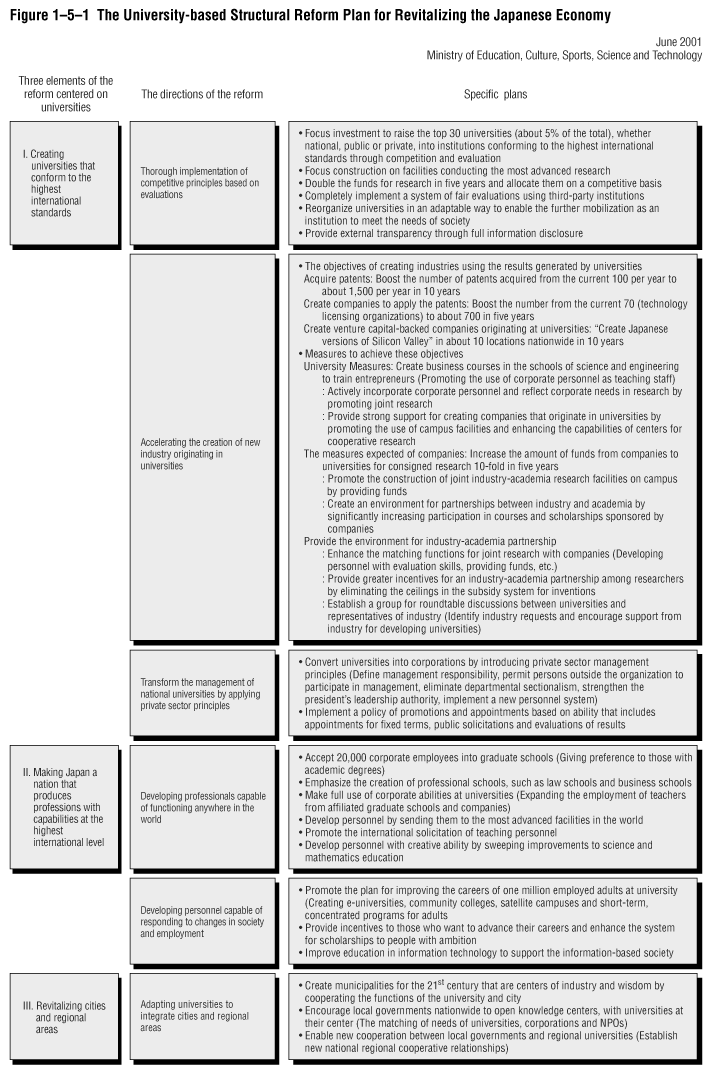| Home > Policy > White Paper, Notice, Announcement > White Paper > Japanese Government Policies in Education,Culture,Sports,Science and Technology 2001 >Chapter5 | ||
It is important to build world-class universities as they constitute the intellectual foundation for a dynamic society and prosperous economy. In particular, the establishment of a third-party evaluation system and the enhancement of fluidity among personnel within university teaching and research staffs are urgent tasks to be addressed. The former monitors the allocation of funds while the latter contributes to more active educational and research activities in a competitive environment.
In regard to the reform of universities, ever since the establishment of the University Council in 1987, measures such as the quantitative and qualitative improvement of graduate schools and the deregulation and improvement of university administration and management have been taking place to realize more advanced education and research, more individualized higher education and more active university administration and management. In 1998, the University Council submitted a report, A Vision for the University of the 21st Century and Future Reform Measures: Distinctive Universities in a Competitive Environment, which built upon the progress of university reforms at that time. The report presented the basic policies of university reforms as follows:
University reforms have been promoted since the time of the report in accordance with its basic policies.
To further promote educational reform, Policies for the Structural Reform of Universities (National Universities) defined the future direction of reform in June 2001, with a view to making universities more dynamic and internationally competitive. It stipulated: {1} the realignment and consolidation of national universities should be boldly pursued; {2} management methods of the private sector should be introduced into national universities; and {3} a competitive mechanism with third-party evaluation should be adopted by universities.
The realignment and consolidation of national universities in {1} above was introduced to try to establish a flexible and bold educational and research foundation that will contribute to the competitiveness of national universities.
The private sector management methods referred to in {2} above are to turn national universities into newly independent administrative institutions and require outside participation in university administration and merit-based human resources management.
The competitive mechanism with third-party evaluation in {3} above tries to improve educational and research standards of both public and private universities throughout Japan. Third-party evaluation, which is objective and fair, is expected to create a competitive environment for not only national universities but also private and other public universities. The results of the evaluation will be used in connection with resource allocation.
Along with the Policies for the Structural Reform of Universities (National Universities), MEXT prepared the University-based Structural Reform Plan for Revitalizing the Japanese Economy. The plan further clarified the future direction of reforms and concrete measures to build the world's best universities and create a nation with abundant human resources.
|
1 Take bold steps to reorganize and combine national universities - Reorganize and combine based on the conditions at each university and in each sector
- Reduce and reorganize the system for training educational personnel (Also consider transferring authority to local government)
- Merge single curriculum universities such as medical universities with other universities (Also consider transferring authority to local governments) - Reorganize and merge universities and faculties into units covering more than one prefecture - Aim to sharply reduce the number of national universities → Revitalize universities using a scrap and build policy 2 Introduce management techniques based on private-sector concepts in national universities
- Employ outside specialists as university administrators and in management organization
- Operate universities promptly and strategically by defining management responsibility
- Introduce a new personnel system based on rewarding ability and results
- Spin off and make independent some functions of national universities (Introduce an independent profit system)
- Include primary and secondary schools attached to universities and business schools in these considerations
→ Shift quickly to new "national university corporations" 3 Introduce the principles of competition in universities by using third party evaluations - Introduce a third-party evaluation system in which specialists and other private sector personnel participate
- Cooperating National Institution for Academic Degree and other organizations
- Fully disclose the results of the evaluations to the citizens and society, including students, companies and organizations providing assistance - Give priority to fund distribution based on the evaluation results - Expand competitive funding among national, public and private universities → Develop the top 30 national, public and private universities into institutions conforming to the highest international standards |

| Back To Top | MEXT HOME |